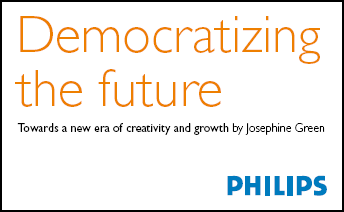Those lucky enough to attend last week’s IIT Institute of Design’s Strategy Conference got a chance to see some great presentations from some major innovation thought leaders. I was not one of them, but I have been going throught the materials from the conference which are publicly available. As a proponent of Open Innovation, I particularly enjoyed reading the presentation given by Josephine Green of Philips Design which introduced the concept of social innovation.
Realizing that innovation driven solely by technology often failed to meet customer needs, many organizations turned to a consumer (marketing) oriented approach where consumer research and observation is handled by “experts”. Green believes that this approach is starting to reaching end of life.
Her main point is that we need to go beyond designing around individual consumer needs and start innovating around social needs. Her reasoning: We have reached a saturation point for technology and consumer goods. Continuing to consume the way we currently do is not healthy.
“There is too much ‘stuff’ and a growing realization that filling the future with more and more consumer-driven technology and marketable goods does not necessarily guarantee higher growth, a better quality of life or even life itself, given the state of the planet.”
So what exactly is Social Innovation? According to Green, it goes beyond looking at individual consumer needs to look at the relationship between people and the products/services they use. It involves engaging experts, customers and creative communities to envision, build and deliver products and services which better reflect the needs and values of the future consumer. Green believes that this shift from a Consumer/Market-led approach to a People/Social-led approach is being driven by three factors:
- Diversity: our world is becoming increasingly small, with many different cultures, beliefs, opinions and behaviors all living together. Along with increased clashes, this closeness has led to an understanding of our differences.
- Creativity: Social Media tools have put the consumer in a position of power and they are increasingly becoming “the supplier of content, taste, emotions and goods.” They no longer want choice, they want a participatory role in designing the things they consume.
- Wellbeing: There is a growing awareness that our ever increasing pace of life and consumption is having a correspondingly negative impact on the environment, the poor, and our own quality of life. Health and wellness, connectedness, personal growth & control are replacing material things as the way to measure wellbeing.
What will be the implications of this shift for today’s companies? First and foremost, you must begin establishing a dialogue with your customers. You will need to facilitate conversations between customers and your designers. Second, you need to develop a Sense & Respond competency and be able to support fast prototyping. Third, you must get really comfortable with relinquishing control of some of the development process to your customers. They are already in control of your destiny in case you hadn’t noticed.
